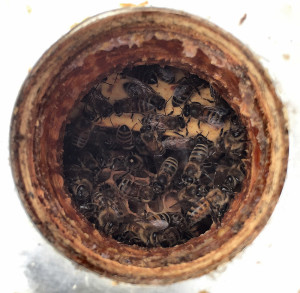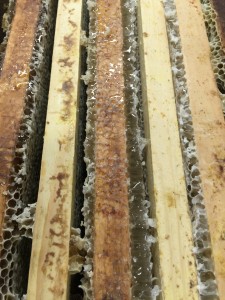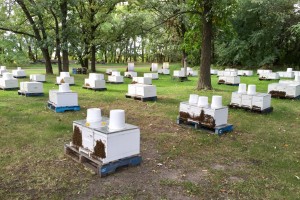Year in Beekeeping

January – February
These are usually the slowest months for Manitoba beekeepers. Bees are tucked away for the winter. This is the perfect time to make frames, check super condition or make new equipment.
March – April
Bees are moved outside late March to first week in April depending on weather conditions. We treat all hives for mites and get them off to a good start. Weak hives are requeened or merged with other stronger hives. Deadouts (dead hives coming out of winter) are cleaned and prepped for a new hive. For beekeepers who ordered package bees, they will usually receive them in April or May.

We will also feed each hive with about 2 litres of 1:1 sugarwater. We use inverted pails on the hive tops to ensure each hive gets its share. When we are finished feeding, hives are ready to be moved to summer locations. This usually happens mid May.
May – June
Mid May is time for splitting and equalizing hives. This is the time to play Robin Hood; stealing from the rich and giving to the poor. The goal is to have at least 1 box bees by end of May and 2 boxes bees by end of June. Anything stronger than this becomes a risk of swarming in July. My personal deadline for splitting is last week of May. Otherwise, they are too weak for the honey flow.
If we want to increase, this is a great time for transferring strong nucs into regular hives. My nucs are 6 frames and they are transported into regular 10 frame boxes. A strong queen will have them filled with brood in no time. We want to see 8 frames brood in the hives at this point. This will ensure that the hive will have the population required for honeyflow.

This is also the beginning of making nucs and queen rearing. We take two frames brood and one honey/pollen from stronger hives to make up new nucs. Nucs are made to build in the the current season, winter and become producers the following season.
July – August
This is when the magic happens. It’s the busiest time in the beekeeping season; adding supers, taking them off again, extracting, catching swarms, and making nucs. Not to mention bottling honey, and creaming fresh honey. Many customers come in these two months to get their annual supply.
May to August are by far the busiest months of the year for beekeepers.
September – October

These months are all about winter preparations. It involves treating hives for mites and feeding 2:1 sugar water. Hives that are dying are usually merged with other hives as it’s usually too late to do much about them.
November – December
We move our bees indoor first week in November on most years. I usually clean dead bees every 10 days or so from the wintering room. This is also a good time to process beeswax and making candles. You can also clean queen excluders and check your woodenware to ensure you’re ready for next season. If you want to change or upgrade equipment, this is the time to do it.